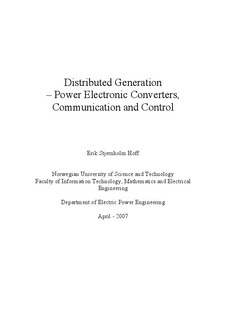| dc.contributor.advisor | Norum, Lars Einar | nb_NO |
| dc.contributor.advisor | Undeland, Tore Marvin | nb_NO |
| dc.contributor.author | Hoff, Erik Stjernholm | nb_NO |
| dc.date.accessioned | 2014-12-19T13:29:27Z | |
| dc.date.available | 2014-12-19T13:29:27Z | |
| dc.date.created | 2007-09-03 | nb_NO |
| dc.date.issued | 2007 | nb_NO |
| dc.identifier | 122621 | nb_NO |
| dc.identifier.isbn | 978-82-471-1965-5 | nb_NO |
| dc.identifier.uri | http://hdl.handle.net/11250/249713 | |
| dc.description.abstract | This thesis tries to explain the changes in the control of power electronic converters that are possible by the use of communication. Many of the renewable energy sources such as photovoltaic panels are geographically dispersed. The power rating per generator is therefore typically low. If this kind of energy source should dominate an electrical grid, the number of generators must be high. There should also be means of controlling this large number of generators simultaneously and safely. The cost of safe communication may be too high compared to the power contribution of a single generator. The Internet offers a low-cost solution, but it cannot guarantee real-time properties. Similarly to the Internet itself, it is shown how communication errors can be detected and handled in a safe manner by the end-system, in this case the generator. The generator can detect a communication timeout, and change control algorithms in order to guard itself and the connected electricity grid. When necessary, it can also disconnect and work as a local standalone power supply. In order to be able to supply all kinds of loads, the generator (in this case an inverter) is primarily voltage controlled. This results in challenges concerning current distortion. The use of feed-forward for cancellation of common grid voltage harmonics is discussed, simulated and measured. An anti-islanding algorithm for voltage controlled inverters is also developed, simulated and measured in this thesis. A DC/DC-converter for optimized connection of a photovoltaic panel is built, exploiting the photovoltaic panel properties to reduce the size and the losses significantly. Although most contributions are connected to details and parts of the system, the interactions between communication and control are emphasized. | nb_NO |
| dc.language | eng | nb_NO |
| dc.publisher | Fakultet for informasjonsteknologi, matematikk og elektroteknikk | nb_NO |
| dc.relation.ispartofseries | Doktoravhandlinger ved NTNU, 1503-8181; 2007:89 | nb_NO |
| dc.subject | Distributed Generation | en_GB |
| dc.subject | Control | en_GB |
| dc.subject | Power Electronic Converters | en_GB |
| dc.subject | Communication | en_GB |
| dc.subject | TECHNOLOGY: Electrical engineering, electronics and photonics: Electric power engineering | en_GB |
| dc.title | Distributed Generation - Power Electronic Converters, Communication and Control | nb_NO |
| dc.type | Doctoral thesis | nb_NO |
| dc.source.pagenumber | 180 | nb_NO |
| dc.contributor.department | Norges teknisk-naturvitenskapelige universitet, Fakultet for informasjonsteknologi, matematikk og elektroteknikk | nb_NO |
| dc.description.degree | PhD i elektronteknikk | nb_NO |
| dc.description.degree | PhD in Electrical Engineering | en_GB |
